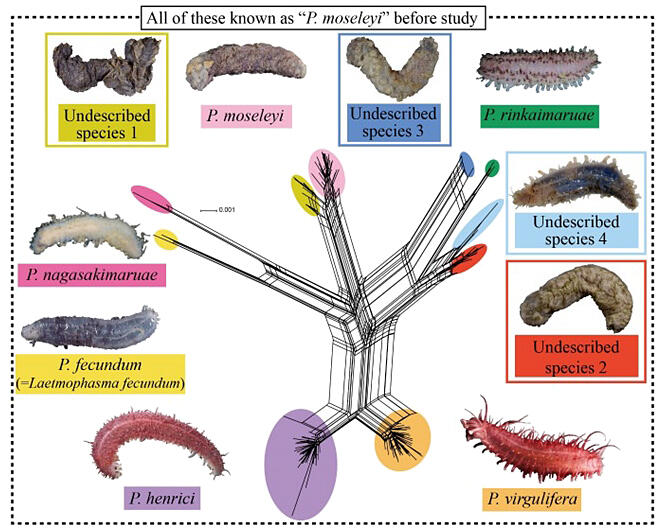A research group led by Assistant Researcher Akito Ogawa of the Center for Molecular Biodiversity Research, Department Director Toshihiko Fujita of the Department of Zoology at the National Museum of Nature and Science, Tokyo and Associate Professor Shimpei Hiruta of the Mt. Fuji Institute for Nature and Biology, at Showa University (Affiliated Researcher at the National Museum of Nature and Science), in collaboration with the Shirshov Institute of Oceanology in Russia, National Institute of Water and Atmospheric Research in New Zealand, the Museums Victoria Research Institute in Australia, and the Japan Agency for Marine-Earth Science and Technology, has revealed that the genus Pannychia in the Pacific Ocean, which was considered as a single species, consists of 10 species, including four potentially new species, based on genetic analyses of specimens from museum collections around the world. The study was published and released online in Marine Biology on December 24, 2024.

Provided by the National Museum of Nature and Science
Pannychia holothuroids inhabit the deep-sea floor in the Pacific Ocean at depths of approximately 200-2,600 meters. They are frequently observed around Japan and are representatives of large organisms on the bathyal seafloor in the Pacific Ocean. Individuals of Pannychia have bodies covered by a soft epidermis that is prone to exfoliation. Specimens collected by bottom trawling, which is a primary method of collecting deep-sea organisms, are dragged and damaged resulting in the loss of their epidermis, and thus, it has been difficult to accurately classify them through morphological comparisons. For this reason, the genus Pannychia in the Pacific Ocean has been considered as a single species, and P. moseleyi has been thought to distribute throughout the Pacific Ocean. However, with recent advances in survey techniques using submersibles to observe the seafloor and genetic analysis techniques, the possibility that the genus Pannychia in the Pacific Ocean may include multiple species with different morphological and genetic characteristics have been suggested.
In this study, Ogawa's group visited museums and research institutions in Japan, Australia, New Zealand, the United States, and Russia, in addition to the National Museum of Nature and Science, to examine specimens in their collections. In total, they examined specimens from six museums and research institutions around the world. Specifically, the research group examined 178 specimens of the Pannychia holothuroids collected in the Pacific, Indian, and Antarctic Oceans between 1986 and 2019. They re-evaluated species diversity and species boundaries (species definitions) of the Pannychia based on analyses with the DNA barcoding (using the COI gene) and the MIG-seq method (using a genome-wide single nucleotide polymorphism data), as well as a detailed morphological comparison.
As a result, they discovered 10 distinct groups within the formerly considered single species Pannychia holothuroids that differs from each other in terms of genetic and morphological characteristics. Accordingly, they proposed to treat each of these 10 groups as a distinct species. For six of these 10 species, scientific names had been proposed in previous studies, and these were identified as P. moseleyi (Japanese name: Murasaki-hage-namako), P. virgulifera (Hage-namako), P. henrici (Shinkai-hage-namako), P. nagasakimaruae (Nagasaki-hage-namako), P. rinkaimaruae (Misaki-hage-namako), and Laetmophasma fecundum (a species from the Eastern Pacific Ocean). Meanwhile, the remaining four species were considered undescribed species (potentially new species). Consequently, Pannychia moseleyi, believed to be the single Pannychia species distributed throughout the Pacific Ocean, was found to be actually a species complex situation including 10 species.
With the aim of the description of the four undescribed species (potentially new species) discovered in this study as new species, the research group will conduct detailed morphological comparisons between the four species with known Pannychia species. They also plan to conduct comparative genetic and morphological analyses in areas where only limited specimens were used for this study (e.g., Eastern Pacific Ocean, Indian Ocean, and Antarctic Ocean), to further elucidate the species diversity on a global scale. Future re-evaluation of the diversity of deep-sea species, as conducted for the genus Pannychia, is expected to contribute to deepening our understanding of the diversity of deep-sea ecosystems, which has been studied less extensively and overlooked compared to terrestrial and coastal ecosystems and elucidating the distribution and diversification patterns of organisms in the deep-sea, an environment shrouded in mystery. Moreover, integrative research combining morphological comparisons and genetic analyses using museum collections will be an effective method for elucidating the diversity of widely distributed species, such as deep-sea organisms.
Journal Information
Publication: Marine Biology
Title: Molecular phylogenetic re-evaluation of deep-sea holothuroid genus Pannychia based on COI gene and genome-wide SNPs data
DOI: 10.1007/s00227-024-04570-8
This article has been translated by JST with permission from The Science News Ltd. (https://sci-news.co.jp/). Unauthorized reproduction of the article and photographs is prohibited.




